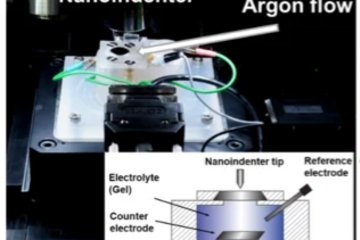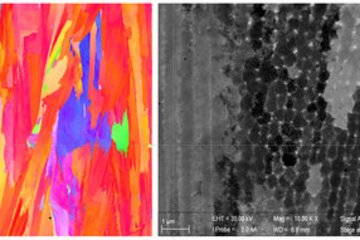All genres
261.
Conference Paper
Direct atomic scale observation of dynamic alumina-aluminum solid-liquid interfaces. In: The 8th Asia-Pacific Conference on Electron Microscopy (8APEM): In Conjunction with the 60th Annual Meeting of the Japanese Society of Microscopy, pp. 671 - 672. 8th Asia-Pacific Conference on Electron Microscopy (8APEM), Kanazawa, Japan, June 07, 2004 - June 11, 2004. Die Japanische Gesellschaft für Mikroskopie, Uchinada-mati (Isikawa-ken), Japan (2004)
262.
Conference Paper
Interface Structure of Epitaxial Cu Films on (0001) α-Al2O3. In: Proceedings of the 14th ICEM, Vol. 2, pp. 567 - 568. 11th International Congress on Electron Microscopy, Dublin, Ireland, August 26, 1996 - August 30, 1996. (1998)
263.
Conference Paper
Structure and Composition of Interfaces in Ceramics and Ceramic Composites. In: Proc. of the International Materials Symposium on Ceramic Microstructures: Controll at the Atomic Level, pp. 1 - 12 (Eds. Tomsia, A. P.; Glaeser, A.). International Materials Symposium on Ceramic Microstructures: Controll at the Atomic Level, Berkley, CA, USA, June 24, 1996 - June 27, 1996. Plenum Press, New York (1998)
264.
Conference Paper
Microstructure of Nb Based Al2O3 Composites. In: Proc. of 56rd Annual Meeting of MSA, pp. 588 - 589. 56rd Meeting of the Microscopy Society of America, Atlanta, GA, USA, July 12, 1998 - July 16, 1998. (1998)
265.
Conference Paper
Microstructure of Ni2B Laser-Induced Surface-Alloyed α-Fe. In: Laser Materials Processing, Vol. 83a, pp. 128 - 137. International Congress on Applications of Lasers and Electro-Optics’97, San Diego, CA, USA, 1997. (1997)
266.
Conference Paper
Atomic Structure of Internal Cu/Al2O3 Interfaces. In: Proc. of 54th annual meeting of MSA, Vol. 3, pp. 686 - 687. 54th Meeting of the Microscopy Society of America, Minneapolis, MN, USA, August 11, 1996 - August 15, 1996. (1996)
267.
Meeting Abstract
Influence of Shell Thickness on Durability of Ru@Pt Core-Shell Catalysts for Reformate PEM Fuel Cells. In ECS Meeting Abstracts, MA2022-01 (35), p. 1528. The Electrochemical Society (2022)
268.
Talk
Investigation of planar defect evolution in Au–Pd–Pt–Ru-based compositionally complex solid solution thin films using analytical transmission electron microscopy. The 2025 Fall Meeting of the European Materials Research Society (E-MRS), Warsaw, Poland (2025)
269.
Talk
Revealing relations between structural complexity and electrocatalytic activity in Au–Pd–Pt–Ru compositionally complex solid solution thin films. The 2025 Materials Research Society (MRS) Fall Meeting & Exhibit, Boston, MA, USA (2025)
270.
Talk
New insights into thermoelectric materials through length-bridging characterization. Transverse Effects in Thermoelectric Systems 819. WE-Heraeus-Seminar, Bad Honnef, Germany (2024)
271.
Talk
Triggering and tracking grain boundary phase transformation at atomic resolution. European Microscopy Conference EMC 2024, Copenhagen, Denmark (2024)
272.
Talk
Unlocking the Stability of Ceramics in (Photo)Electro-Chemical Application and the Role of Defects. Gordon Research Conference on Solid State Studies in Ceramics at the Mount Holyoke College, South Hadley, MA, USA (2024)
273.
Talk
In situ STEM observation of thermoelectric materials under heating and biasing conditions. The 6th joint Sino-German workshop on advanced & correlative electron microscopy of catalysts, quantum phenomena & soft matter, Bad Honnef, Germany (2024)
274.
Talk
Insight in defects of energy materials: Aberration corrected STEM imaging coupled with 3D atom probe tomography. Colloquium Ludwig-Maximilians-Universität, München, Germany (2024)
275.
Talk
In situ microstructural observation and electrical transport measurements of PbTe thermoelectrics by transmission electron microscopy. International Conference on Thermoelectrics ICT, Krakow, Poland (2024)
276.
Talk
Electron Energy-Loss Spectroscopy in a Scanning Transmission Electron Microscope: A versatile tool to study bonding characteristics in materials. Atom Probe Tomography: A local probe of chemical bonds in solids?, Aachen, Germany (2024)
277.
Talk
Grain boundary-controlled lithiation of Li-solid solution systems for lithium metal batteries. International Operando Battery Days, Grenoble, France (2024)
278.
Talk
Spectroscopy. Electron Microscopy Spring School of the yDGE, Berlin, Germany (2024)
279.
Talk
Hematite for light induced water splitting – improving efficiency by tuning distribution of Sn dopants at the atomic scale. The International Symposium on Advanced Coatings for Energy – ISC4E 2023, Ben Guerir, Morocco (2023)
280.
Talk
Determining the degradation mechanisms and active species of electrocatalysts by identical location electron microscopy. NRF-DFG meeting “Electrodes for direct sea-water splitting and microstructure based stability analyses”, Korean Institute for Energy Research, Jeju, South Korea (2023)











